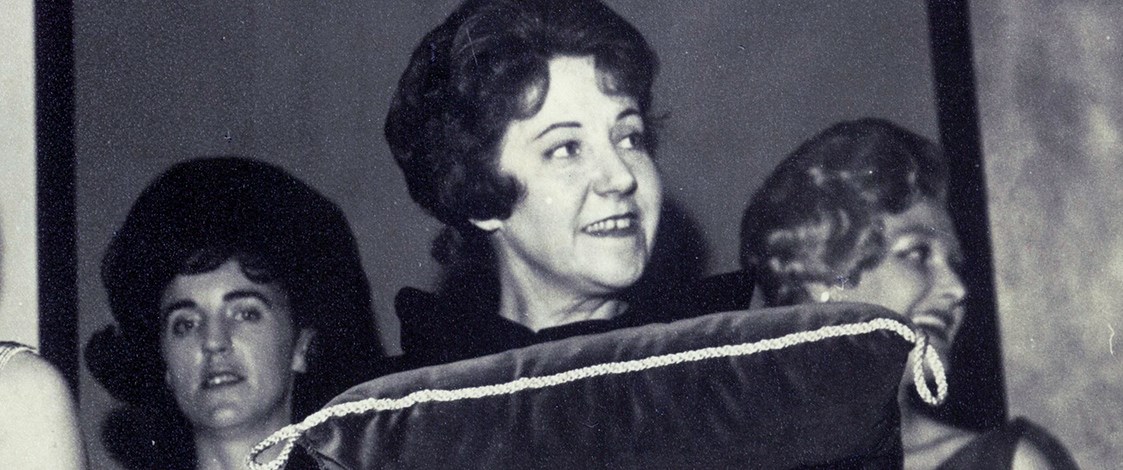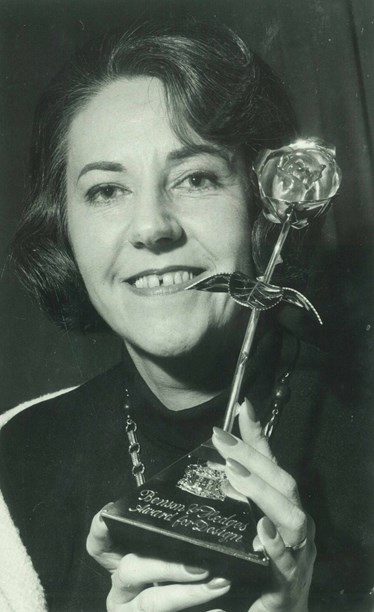Stories
Peggie Wilson
1919–2015

Australian designer, Peggie Wilson, lived in New Zealand for only a little more than two decades but her contribution to the local fashion industry was considerable.
Peggie Corlett was born in 1919. Her father, Manson Corlett had travelled to Melbourne from Nelson, New Zealand in the early 1900s, where he opened the Corlett & Sons printing works. Peggie’s mother, Blanche, was an artist and seamstress who designed and made all of her daughter’s clothes. It was the combined influence of her parents, Peggie concluded, that led to her love of fashion, design and style.
After graduating as dux of her school in 1934, Peggie was desperate to become involved in the world of fashion. "The best way of getting started in fashion at the time was to try and obtain an apprenticeship with a couturier. I was fortunate enough to find a job with the best – Charles Osborne Shave – who was recognised as Melbourne’s leading fashion designer at the time."
For the first month of her apprenticeship, all she was allowed to do was pick up pins from the studio floor. "I grew to understand how important it is to be patient – and to be prepared to learn a skill from the ground up!"
When she completed her apprenticeship in 1936, her parents helped her to establish her own millinery and dress-making business, Peggie Corlett Dressmaking and Millinery, located in the bustling Melbourne suburb of Flemington, home of the Melbourne Cup. Peggie was 17 years old.
Soon after, Peggie met her husband-to-be, Len Wilson, who had recently arrived in Melbourne from Christchurch. They married in 1942 when Len was home on leave from the Australian Infantry Force. During the war, women were asked take on vital roles in the workforce and Peggie put her business aspirations on hold to work as a conductress on Melbourne’s tram network.
After the war, Peggie signed on as an instructor at Richmond Technical College where she taught designing, cutting and dressmaking until the birth of her daughter, Jan, in 1947. Her son Greg was born in 1952 and for a further five years she concentrated on the responsibilities of motherhood until, in 1957, she found herself yearning to get back into the world of fashion and beauty.
As a step in that direction Peggie decided to enrol for a course at the Elly Lucas School of Elegance, a prominent Melbourne finishing and modelling school. After graduated at the top of her class she was invited to become a tutor and worked at the school in that role for the next three years. “I realised I had a natural aptitude for the field. And, being ambitious, I soon started to dream about opening my own deportment and modelling school.”
Peggie didn’t want to start a business in Melbourne that would compete with Elly who by then had become a close friend. Peggie and Len began looking at other options and in the end made the decision to move to Auckland where they established The Academy of Elegance in 1960.
The 1960s and 1970s were the heyday of international beauty quests. Under Peggie’s expert guidance, countless Academy pupils went on to achieve success in this field and in the world of modelling. Former pupils include Leone Maine, Maureen Kingi, Gay Phelps, Heather Gettings and Glenys Treweek – all winners of the Miss New Zealand competition during this era.
'The Academy', as it was affectionately called by its students, was originally located at 1 Wolfe Street in Auckland City (although it later moved to 36 Customs Street). The studios comprised a reception area, administration office, a separate workroom and dressing room areas. There were two classrooms – each measuring approximately 10 metres by 25 metres, with a central catwalk and make-up mirrors extending along one wall.
The Academy’s symbol was an elegant, long-stemmed gold rose with the tagline 'Simplicity is Elegance'. "As for design, think '1960s Madison Avenue' style," Peggie recalled. "Modern, elegant simplicity with a slightly oriental influence. High ceilings, white walls, cork tile floors, tall black and white striped curtains at either end of the room; Japanese shoji screens, black laminate desks, pearl-white woven-cane chairs for the students and turquoise feature furnishings."
A typical Academy course would run for 20 weeks with students attending one, two-hour class each week. "The majority of our courses were designed for what we then termed 'business girls' and were held on weekday evenings from 6pm to 8pm. But we also had daytime classes for 'housewives' and school holiday and Saturday morning classes for teenagers. Advanced classes and special modelling classes were held in the evenings from 8pm to 10pm, after regular evening classes were finished."
Academy courses covered deportment and posture, personal grooming, skin care and make-up, hair care and styling, dress sense, wardrobe planning, use of colour and accessories, etiquette, speech and confidence and personal presentation. After several years, the Academy also introduced special grooming and personality development courses for men. Throughout this era the Academy expanded rapidly, adding a modelling agency, hairdressing salon and even a specialist business college, which attracted local and overseas students.
Peggie and Len also opened a branch of the Academy in Wellington in 1963, which they sold three years later to Jill Von Kohorn (née Bussell). They also developed a cosmetics range, Blanche Corlett, named after Peggie’s mother. "At the height of the business in the early 1970s, demand was so great that we would typically be conducting 12 to 20 classes every week, with 20 to 30 students in each class."
The Academy remained an iconic part of the Auckland fashion and beauty scene for 16 years until, in 1976, as a result of rapidly changing social trends and an extended period of economic difficulty, Peggie and Len made the difficult decision to close the doors. However, Peggie continued to work as a consultant lecturer at businesses and schools, and she also continued her work as a fashion designer.
Peggie’s first competitive involvement as a fashion designer had been an entry in the Australian Gown of the Year Contest in 1959. Throughout the Academy era, fashion remained extremely important to her and she continued to design, sometimes using the Golden Shears label (no relation to the Golden Shears competition). She used the Academy studio as her base, but also designed and sewed at home.
In New Zealand she won numerous awards, including the Benson & Hedges Gold Rose Award for Fashion Excellence and the 1962 Golden Shears Awards.
In 1963 she placed third in the New Zealand Gown of the Year contest with a tiered dress called 'Vienna Bonbon'.
Peggie Wilson's 'Vienna Bonbon' in a parade fashion parade at Sorrento restaurant in 1964. Photos by Rykenberg Photography from the Auckland Libraries Heritage Collection, 1269-W212-24.
Her work has been exhibited by invitation in the Australian Gown of The Year and the Benson & Hedges Fashion Design Hall of Fame.

Peggie Wilson won the Benson & Hedges Gold Rose Award in 1965 for an evening gown called 'Virgo'. Image © Greg Wilson.
Peggie and Len returned to Australia in 1981 to be closer to their son in Brisbane. Len died soon after, but Peggie stayed in Queensland. She continued her work in fashion and personal improvement, giving lectures to schools, business houses and community organisations. In 2008, at the age of 89, she published a book, What’s Age Got to Do With It?
Text by Greg Wilson and Kelly Dix. Banner image of Peggie Wilson accepting the Golden Shears Award, 1962.
Last published June 2015.